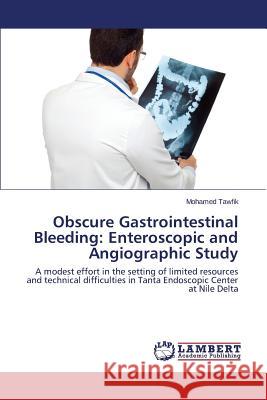Obscure Gastrointestinal Bleeding: Enteroscopic and Angiographic Study » książka
Obscure Gastrointestinal Bleeding: Enteroscopic and Angiographic Study
ISBN-13: 9783659689604 / Angielski / Miękka / 2015 / 172 str.
Acute GI Bleeding is a common emergency condition. Approximately 3-5 % of patients with GIB have no source found by EGD and colonoscope.In most of such case, the responsible lesion is found in the small intestine.In the period from January (2007) to December (2010) a total of 30 patient underwent emergency push enteroscopy (PE) for obscure gastrointestinal bleeding (OGIB) in our endoscopy unit in Tanta university hospital, they were selected from 7195 patients presented with acute gastrointestinal bleeding (AGIB).In the present study the incidence of OGIB among our patients with acute GIB is (0.42%). Enteroscopy seems accurate in the diagnosis of bleeding lesions within its reach in small bowel, not only this but also provides specific therapy to these lesions. Angiography helps to localize bleeding and also suggest the nature of this bleeding lesion.Needless to say, recent endoscopic advances including CE and DBE changed the strategy for diagnosis and management of OGIB in a major way. Formerly, the only option for OGIB was laparotomy, however, with these advances DBE can be used for definitive treatment after CE has localized the bleeding lesion.
Acute GI Bleeding is a common emergency condition. Approximately 3-5 % of patients with GIB have no source found by EGD and colonoscope.In most of such case, the responsible lesion is found in the small intestine.In the period from January (2007) to December (2010) a total of 30 patient underwent emergency push enteroscopy (PE) for obscure gastrointestinal bleeding (OGIB) in our endoscopy unit in Tanta university hospital, they were selected from 7195 patients presented with acute gastrointestinal bleeding (AGIB).In the present study the incidence of OGIB among our patients with acute GIB is (0.42%). Enteroscopy seems accurate in the diagnosis of bleeding lesions within its reach in small bowel, not only this but also provides specific therapy to these lesions. Angiography helps to localize bleeding and also suggest the nature of this bleeding lesion.Needless to say, recent endoscopic advances including CE and DBE changed the strategy for diagnosis and management of OGIB in a major way. Formerly, the only option for OGIB was laparotomy, however, with these advances DBE can be used for definitive treatment after CE has localized the bleeding lesion.











